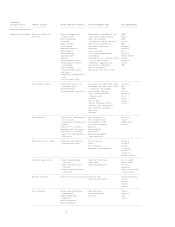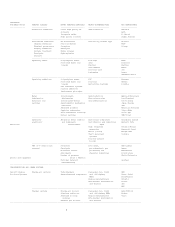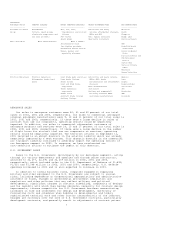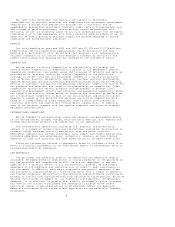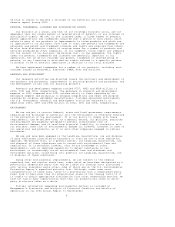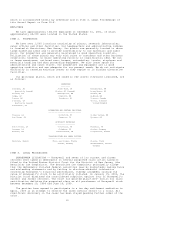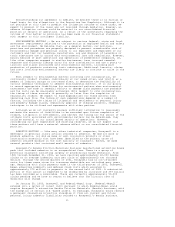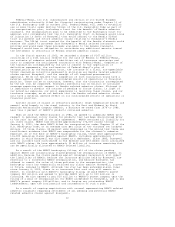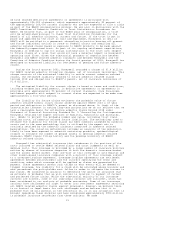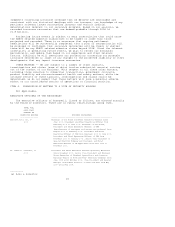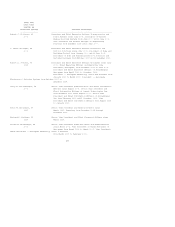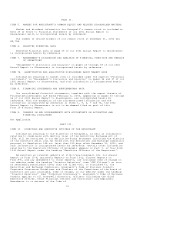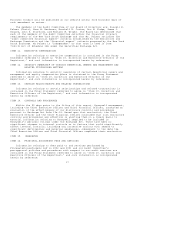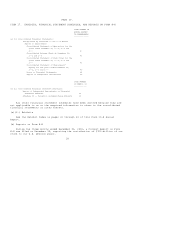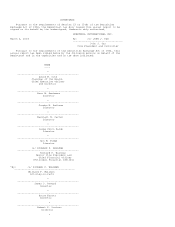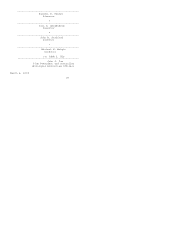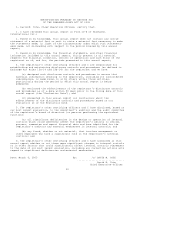Honeywell 2002 Annual Report Download - page 21
Download and view the complete annual report
Please find page 21 of the 2002 Honeywell annual report below. You can navigate through the pages in the report by either clicking on the pages listed below, or by using the keyword search tool below to find specific information within the annual report. Notwithstanding our agreement to mediate, we believe there is no factual or
legal basis for the allegations in the Securities Law Complaints. Although it is
not possible at this time to predict the litigation outcome of these cases, we
expect to prevail if the cases are not resolved through mediation. However, an
adverse litigation outcome could be material to our consolidated financial
position or results of operations. As a result of the uncertainty regarding the
outcome of this matter no provision has been made in our financial statements
with respect to this contingent liability.
ENVIRONMENTAL MATTERS -- We are subject to various federal, state and local
government requirements relating to the protection of employee health and safety
and the environment. We believe that, as a general matter, our policies,
practices and procedures are properly designed to prevent unreasonable risk of
environmental damage and personal injury to our employees and employees of our
customers and that our handling, manufacture, use and disposal of hazardous or
toxic substances are in accord with environmental laws and regulations. However,
mainly because of past operations and operations of predecessor companies, we,
like other companies engaged in similar businesses, have incurred remedial
response and voluntary cleanup costs for site contamination and are a party to
lawsuits and claims associated with environmental matters, including past
production of products containing toxic substances. Additional lawsuits, claims
and costs involving environmental matters are likely to continue to arise in the
future.
With respect to environmental matters involving site contamination, we
continually conduct studies, individually at our owned sites, and jointly as a
member of industry groups at non-owned sites, to determine the feasibility of
various remedial techniques to address environmental matters. It is our policy
to record appropriate liabilities for environmental matters when environmental
assessments are made or remedial efforts or damage claim payments are probable
and the costs can be reasonably estimated. With respect to site contamination,
the timing of these accruals is generally no later than the completion of
feasibility studies. We expect to fund expenditures for these matters from
operating cash flow. The timing of cash expenditures depends on a number of
factors, including the timing of litigation and settlements of personal injury
and property damage claims, regulatory approval of cleanup projects, remedial
techniques to be utilized and agreements with other parties.
Although we do not currently possess sufficient information to reasonably
estimate the amounts of liabilities to be recorded upon future completion of
studies, litigation or settlements, and neither the timing nor the amount of the
ultimate costs associated with environmental matters can be determined, they
could be material to our consolidated results of operations. However,
considering our past experience and existing reserves, we do not expect that
these matters will have a material adverse effect on our consolidated financial
position.
ASBESTOS MATTERS -- Like many other industrial companies, Honeywell is a
defendant in personal injury actions related to asbestos. We did not mine or
produce asbestos, nor did we make or sell insulation products or other
construction materials that have been identified as the primary cause of
asbestos related disease in the vast majority of claimants. Rather, we made
several products that contained small amounts of asbestos.
Honeywell's Bendix Friction Materials business manufactured automotive brake
pads that included asbestos in an encapsulated form. There is a group of
potential claimants consisting largely of professional brake mechanics. From
1981 through December 31, 2002, we have resolved approximately 60,000 Bendix
claims at an average indemnity cost per claim of approximately two thousand
dollars. Through the second quarter of 2002, Honeywell had no out-of-pocket
costs for these cases since its insurance deductible was satisfied many years
ago. Beginning with claim payments made in the third quarter of 2002, Honeywell
began advancing indemnity and defense claim costs which amounted to
approximately $70 million in payments in the second half of 2002. A substantial
portion of this amount is expected to be reimbursed by insurance and $57 million
has been recorded as a receivable. There are currently approximately 50,000
claims pending and we have no reason to believe that the historic rate of
dismissal will change.
On January 30, 2003, Honeywell and Federal-Mogul Corp. (Federal-Mogul)
entered into a letter of intent (LOI) pursuant to which Federal-Mogul would
acquire Honeywell's automotive Bendix Friction Materials (Bendix) business, with
the exception of certain U.S.-based assets. In exchange, Honeywell would receive
a permanent channeling injunction shielding it from all current and future
personal injury asbestos liabilities related to Honeywell's Bendix business.
11



